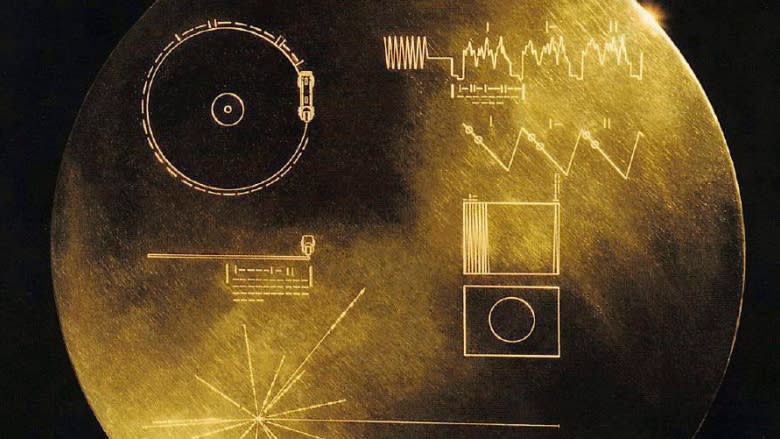'We sent a spaceship to the stars!': Remembering Voyager 2

"It sure doesn't look like a starship."
Those were the words of space artist Jon Lomberg in 1977 as we sat looking out across the swamplands of Cape Canaveral at a slender, silvery missile huddled against a launch gantry. On top of the military rocket was a robotic spacecraft called Voyager 2, which was about to set off on a journey of exploration across our solar system and eventually across the galaxy.
Jon was part of a very small team spearheaded by famous astronomer Dr. Carl Sagan, who had put together a golden record that was attached to the side of Voyager 2 and its twin Voyager 1, to act as a message from Earth to any alien civilizations who might find the spacecraft wandering among the stars in the distant future. The phonograph record (CDs and iPhones had not been invented yet) contains more than an hour of music from many cultures, people saying hello in more than 50 languages, including whales (we don't know what the whales were really saying) and more than 100 photographs that had been digitally encoded onto the disc.
Jon Lomberg designed the cover diagram which shows instructions on how to play the disc, how to interpret the signal, and a star map showing the position of our sun in the galaxy.
The Voyagers were only the 3rd and 4th spacecraft to escape the gravity of the sun and destined to wander indefinitely among the stars of the Milky Way. They followed two other twins called Pioneer 10 and 11. All four robots were able to make interstellar journeys because they flew past the giant planet Jupiter.
If a spacecraft flies past the massive planet in just the right way, it will get a gravity assist that accelerates it, providing the extra velocity it needs to be literally thrown right out of the solar system. The Voyagers would get a second kick from Saturn, with Voyager 2 going on to Uranus and Neptune, making them the fastest objects that had ever sent from Earth.
A billion years
Once they reach interstellar space, there is almost nothing out there to corrode them, so they will be preserved for about a billion years, possibly more. A billion years — that's a thousand million years.
No human artifact has ever lasted that long. Archaeologists have found stone tools from our ancient ancestors dating back about three million years. For something to last a billion years is unheard of.
These are the thoughts that were running through our heads as the final countdown of Voyager began. Then with a brilliant flash from the rocket exhaust, the missile rose into the sky, accelerating faster and faster by the second. Unmanned rockets, which are actually military ballistic missiles, take off much faster than those carrying people because humans would pass out from the forces involved. So, unlike the majestic rise of a space shuttle or the giant Apollo moon rockets, Voyager disappeared from sight like the cartoon roadrunner escaping the coyote.
In less than a minute it was out of sight.
As the sound of the thundering rocket faded and its smoky trail dissolved in the sky, Carl Sagan turned to the group with a huge smile and tears in his eyes, and said, "We sent a spaceship to the stars!"
Indeed we had. Humans would never see it again.
In the van, on the way back to the hotel, everyone was very quiet, pondering the significance of what had just happened. We thought about how the Earth will change during Voyager's unimaginably long journey; how people will fight over lines drawn in the sand, how civilization will flourish, or possibly go extinct, how heat waves and ice ages will come and go, how the continents will shift their positions, so that a billion years from now the Earth and the life on it will be very different from what we see today. And Voyager will still be out there.
Once in awhile, on clear winter nights, I look at the star Sirius, the brightest star in our sky, and the direction Voyager 2 is headed, and think about that little piece of humanity that I watched leave Earth four decades ago. I wonder what it will encounter as it wanders around the galaxy, and whether anyone out there will ever find it. The chances of that encounter are incredibly small, but if it is found by intelligent beings, what will they think about a group of creatures from a small distant planet who had the audacity to reach out to the cosmos?
Another chance
Today, there is only one other spacecraft that is on its way out of our solar system, the New Horizons probe that flew past Pluto in 2015. That robot carries no gold record or message to alien civilizations. But it's not too late.
Jon Lomberg has launched a new campaign called the One Earth Message, which is a crowdsourced project to upload an electronic message onto the spacecraft's computer once its mission is over. The idea is to assemble images and messages from people around the world to represent humanity. (Full disclosure: I'm on the voluntary board of advisors.)
That means you can participate in sending a message to another civilization, a chance to truly reach for the stars.


